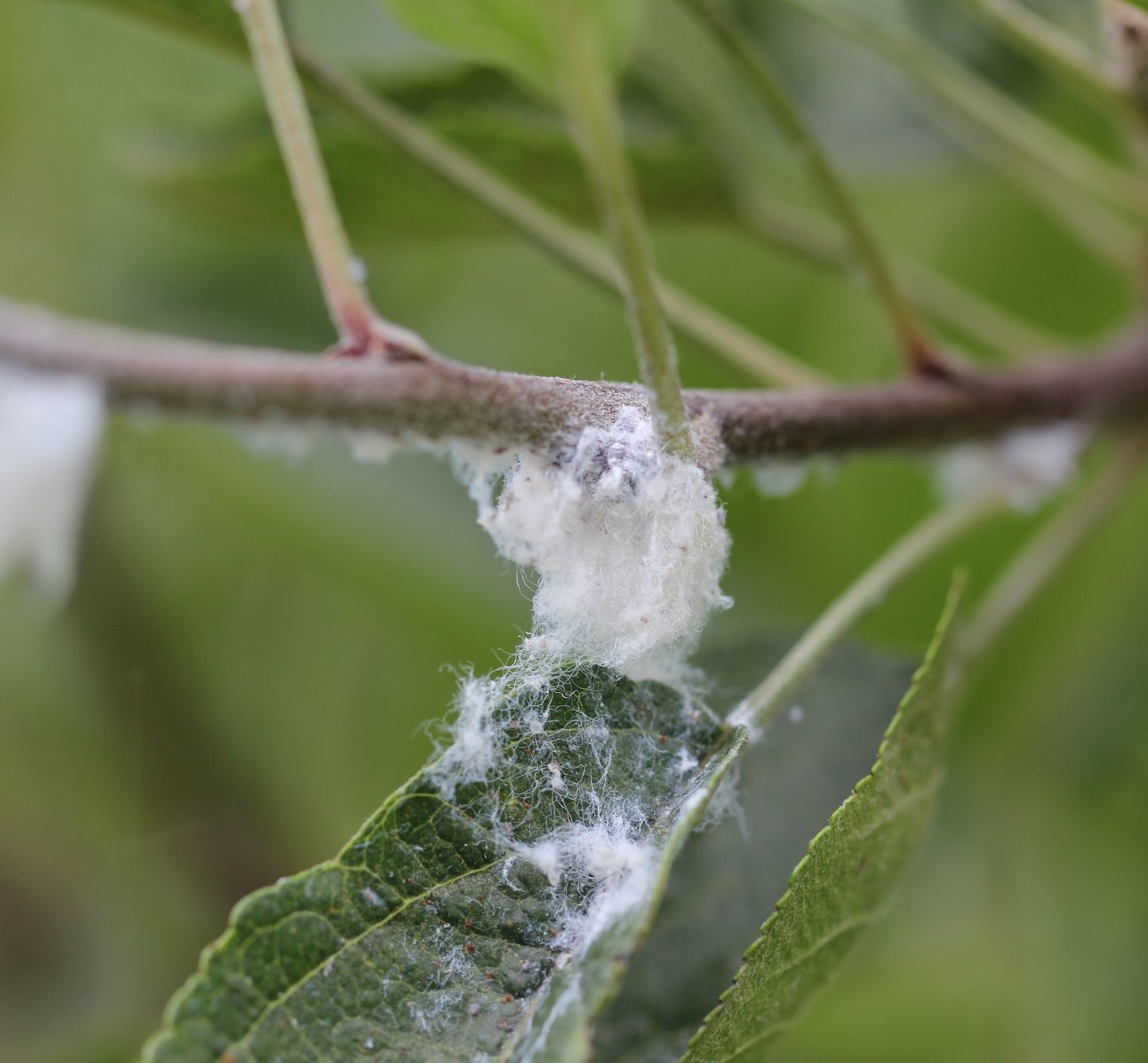Eriosoma lanigerum
Crop: Apple
Why is it a problem? The woolly aphid is a very conspicuous pest on trees of all sizes, but it is mostly a problem on small trees, on which it can stunt growth. Galls can also cause splitting and secondary infections, and root galls can affect nutrient uptake. Although it is often identified by farmers as a pest of serious concern, infestations are generally not serious enough to require management.
Where and when is it a problem? It can cause problems in apple-growing regions. Infestations in Bhutan don’t appear to be sufficient to cause nodules, except in roots.
IDENTIFICATION

Adults are purplish brown and about 2-3 mm long. Colonies are very characteristic, appearing as white woolly masses due to the covering of sticky, white wool. Colonies range in size from 2 mm to 6 cm.
SYMPTOMS

Galls are most common on the roots, but in severe infestations they can also be seen on branches. Galls can then split, providing entry points for disease. Honeydew (sugary excreta) can get infected with sooty mould, fouling fruit. Larger colonies weaken and stunt the growth of small trees. They can also reduce the formation of flower buds and subsequent fruit set in the following year.
Confusion with other pests: No other apple pests make white, woolly colonies.
BIOLOGY
Lifecycle: Woolly aphids overwinter in cracks, loose bark, and on exposed roots. They become active in March and April, and breeding colonies are established under the white sticky wool. Aphids occur on all parts of the plant (twigs, branches, and exposed roots). Part of the population remains on the ground throughout the year.
Dispersal: A few winged aphids are produced in June and July, which may infest other trees, but most natural spread is by young wingless nymphs that crawl or are blown from tree to tree. Strict orchard hygiene is therefore important in limiting the unintentional spread of this pest.
When can damage be expected? Pest populations generally build up relatively slowly.
Hosts: In Bhutan, woolly aphids have only been reported on apples. It has many other hosts but is only known as a serious pest of apples.
MANAGEMENT PRACTICES
This is mainly a problem with young trees. The use of insecticide cover sprays should never be necessary, provided active monitoring and non-chemical management activities are undertaken.
Monitoring
Woolly aphids are a highly visible pest. Monitoring is needed, especially for young trees, which are most susceptible.
Effect of variety
Not known.
Non-chemical management
- For mild infestations, and infestations that can be reached by hand, aphids can be rubbed off with cloth soaked in a bucket of water and kerosene mix (or just water).
- For large scale mechanical control, colonies can be removed from the tree with the powerful jet from a power-spray filled with plain water.
- Suckers should be removed as they provide shelter for aphids.
- Ensure good orchard hygiene practices are undertaken to minimize the spread of colonies within and between trees.
- Application of Tree Spray Oil (30 ml of TSO in 1 litre of water OR 1 litre of TSO in 35 liters of water) in February for San Jose scale will also provide some control of woolly aphids.
Chemical management
- With the exception of treating infected seedlings, chemical spray is only needed in the case of severe infestations, which should not be occurring if monitoring and non-chemical management recommendation are being undertaken. While spraying, care should be taken to thoroughly soak the colonies as they are well protected by wax nurseries.
- Chemical treatment of infected seedlings (where most serious damage occurs from gall formation in roots) is recommended prior to planting to prevent further spread of this insect. Roots of these seedlings should be dipped in a solution of Chlorpyifos before planting (4 ml per 1 litre of water).
- The use of pesticide cover sprays should only be used in the most extreme cases where non-chemical treatments are insufficient. The ideal time to spray is November, after trees have lost their leaves (allowing the chemical to reach the colonies) but before the insect descends to the roots for winter. Use of the systemic insecticide (dimethoate) will give the best results (2 ml per 1 litre of water), but it can only be applied after harvest has finished.
- To help penetration of the pesticide add a small amount (about a teaspoon per 10 litres) of detergent or soap to the chemical and mix in very well. Spray very thoroughly. Spray pressure should be increased so colonies can be well targeted.
- Contact insecticide (Chlorpyrifos at 4 ml in 1 litre of water or Cypermethrin at 1 ml in a liters of water) is needed if spraying when fruits are on the tree. It needs to be applied at least 7 days before harvest.
Check out this link for more information: https://www.nppc.gov.bt/download/wooly-aphid/?wpdmdl=4642&refresh=63a154cee59711671517390
Version: NPPC 2017. Woolly aphid V1.0. Bhutan Pest Factsheet. www.PestsofBhutan.nppc.gov.bt. Date produced: 14 April 2017. Contact: nppcsemtokha@gmail.com
Image acknowledgements: NPPC.



